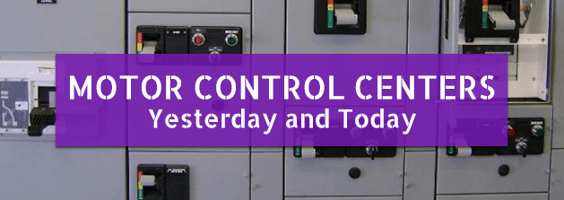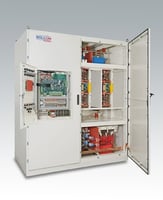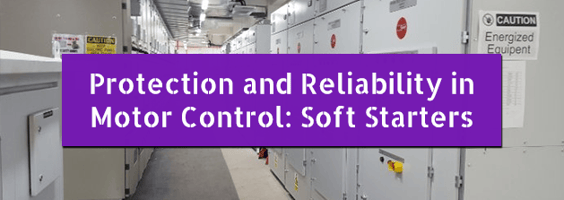What do stadiums and steel mills have in common, other than Pittsburgh pride? Both traditionally...
Replacing DC Motor/Drive with AC Motor/Drive

Utilizing new drive technology has enabled more applications for AC machines where DC machines have typically been used. In the past, DC machines have been implemented for their good torque characteristics throughout a variable speed range. However, some of these older DC drive systems are becoming obsolete and the availability of replacement parts is becoming a concern. This sort of scenario will often be accompanied by consideration for a drive retrofit project. This article covers some key points and comparisons between the two different technologies that may help make that decision a bit easier.
There are benefits to going AC (from an original DC application), but there can also be significant drawbacks. How much each weighs into the equation is based in part on the existing infrastructure and how feasible it is to change. With this in mind, take a look at the general pros and cons of each drive technology.
DC Drives/Motor Combination
Pros |
Cons |
|
Drives are generally less expensive |
Motors are generally more expensive |
|
Drives produce less heat |
Motors require routine maintenance |
|
Drives have smaller footprints |
Motors require separate field supply source |
|
Perform better when high torque at low speeds are required |
Users are increasingly unfamiliar with DC technology |
|
Can handle high impact loads |
AC Drives/Motor Combination
Pros |
Cons |
|
Motors require little to no maintenance |
Drive hardware is more complex |
|
Drives have better power factor |
Line Regen is possible but adds cost |
|
Overall AC system is generally more cost effective than a DC system |
Brake choppers are an option but waste energy and increase heat |
|
Can run motors more efficiently across the whole speed range |
Despite these differences, there are some areas where both DC and AC drives are equal. When looking at state-of-the-art drives, such as the Siemens Sinamics family of drives, both DC and AC drives have comparable features that ease the pain of commissioning. In addition, both drive types are reliable and relatively maintenance-free.
When looking to migrate an existing DC application to AC, there are some engineering considerations that should be taken into account as well:
- Compare the relative footprint of each drive.
- Compare the incoming power requirements.
- Compare cooling requirements.
- Check communication protocols and the ability to interface with the existing process line controls.
- On the motor side, look at the machine footprint and shaft height.
- What about speed - is a gear reduction required since most DC systems are direct drive?
If the intent is to arrive at the same torque output at the motor shaft, the chances are good that the AC motor will take up more volume than the equivalent DC rating. And not all AC machines are created equal: sometimes a squirrel cage induction machine is more cost-effective, sometimes a wound-rotor induction is the better bet, and sometimes a synchronous design is the best choice. And sometimes (believe it or not) the old DC machine is right for the application.
If the existing system is running (even badly) then it is recommended that Amps and Volts be measured over the full range of operation of the system. This will dictate the required power and should also give an indication of where on the motor curve the machine is operating and how far into the field weakening area of the curve the system moves. Speed needs to be measured as well because this will dictate how much torque the new system needs to deliver and at what speed. With this info, a suitable motor can be chosen. This is also the time to pick the cooling arrangement of the motor (sealed, forced air, water, etc.), along with other motor options like the terminal box placement on the motor, thermocouples for windings, bearings, and lube oil.
Mechanical concerns include matching shaft diameter and shaft height which may require new couplings or adapter plates. In addition, motor bases and/or sub-frames may need to be fabricated to accommodate the new motor.
Electrically, care must be taken to how the new drive is tuned because AC drives can respond much quicker than DC drives and this can lead to mismatched response times with existing equipment or other instabilities. To get true DC performance you may need to install an encoder (a must on hoist applications). Also, proper cabling and grounding need to be taken into account because electrical noise may cause issues with the existing equipment - especially instrumentation.
Customers are advised to replace their existing DC equipment with an AC system when:
- The existing DC motor is near its end of life, obsolete, or can no longer be repaired.
- Where power factor and distortion are an issue, such as when the DC motor has a poor power factor when running below base speed, when paying a penalty to the utility provider or needing to add a power factor correction, or when there’s an IEEE 519 requirement.
- The motor is small, generally less than 200 HP, so the cost difference becomes insignificant given the many benefits that will be gained with an AC system
- The machine can be out of service for a longer period of time.
Customers are advised to upgrade their DC drives when:
- The existing DC motor is in decent shape, and spares are readily available
- The existing DC motor is large, greater than 1000 HP or 690V the DC drive replacement costs less than AC system replacement. the DC motor is not easily replaced with an AC motor. This may be because of differing shaft height and shaft diameter, difficult position or hard-to-reach components, or if their application has special cooling needs.
- The situation requires a fast upgrade with minimal downtime.
Are considering replacing your DC equipment with AC equipment and have questions about your decision?
You may also be interested in reading:





